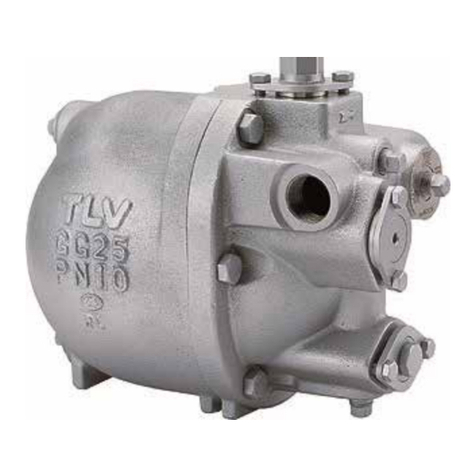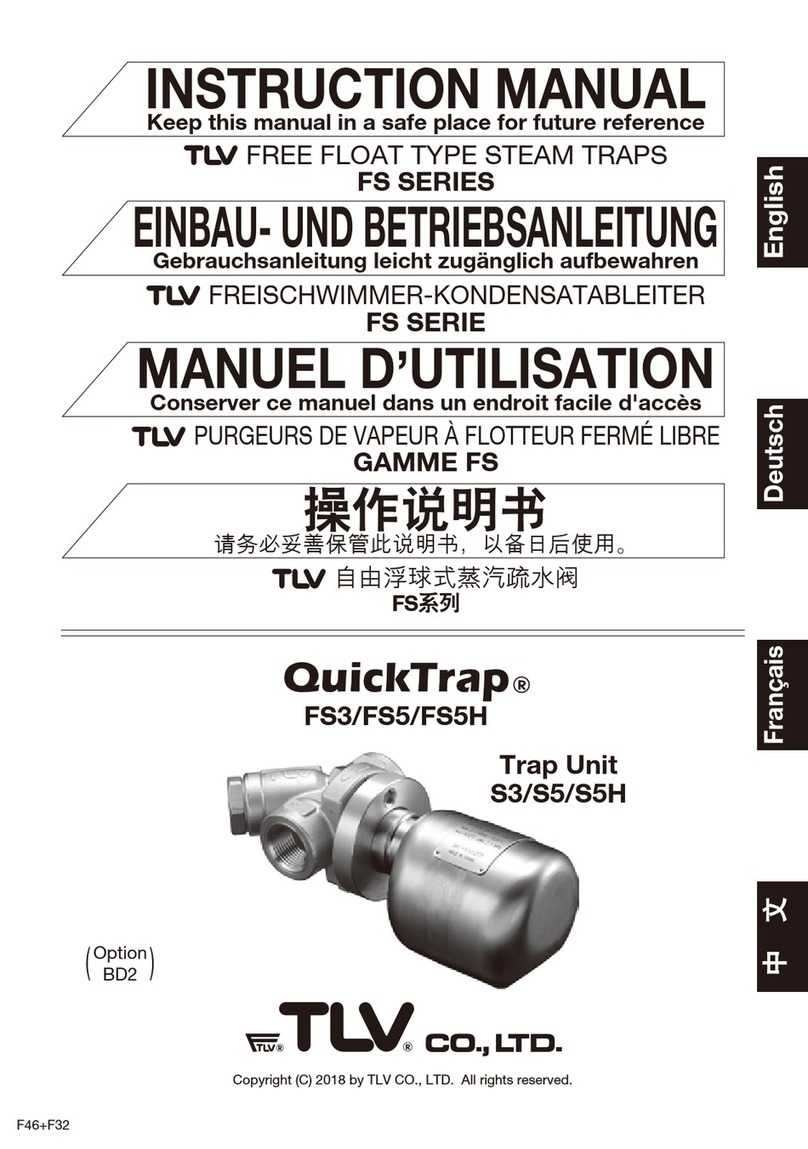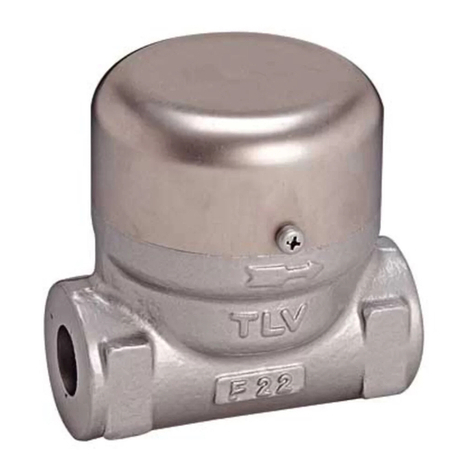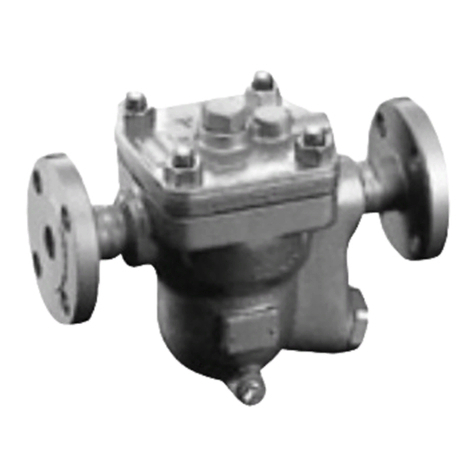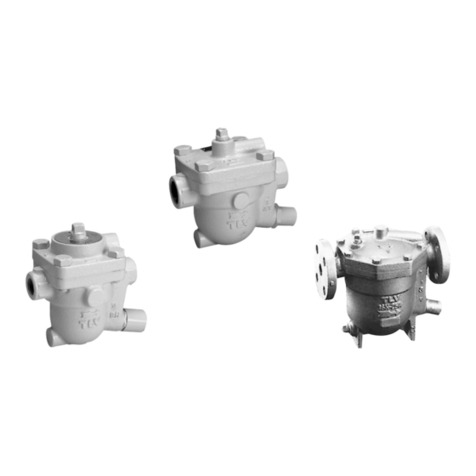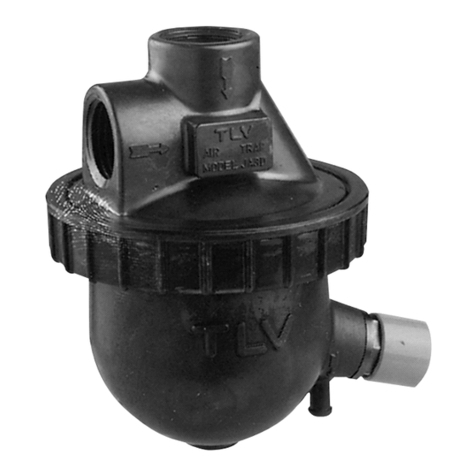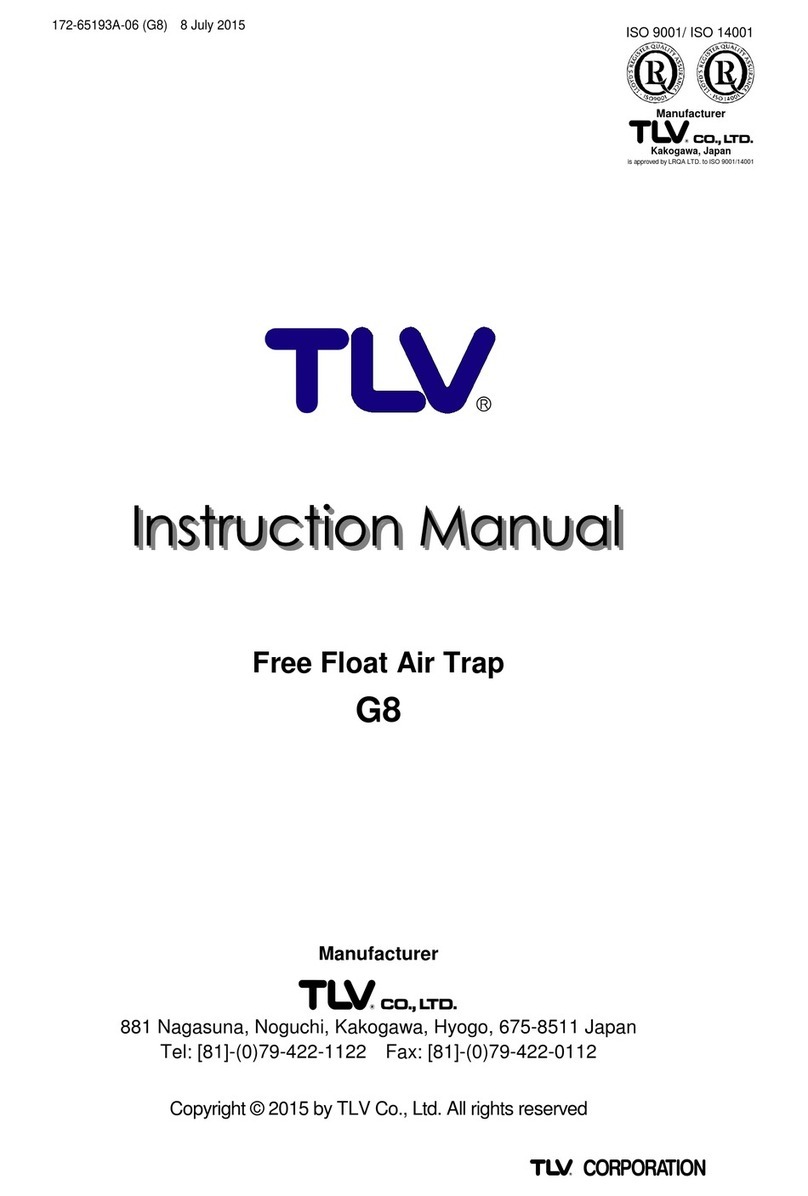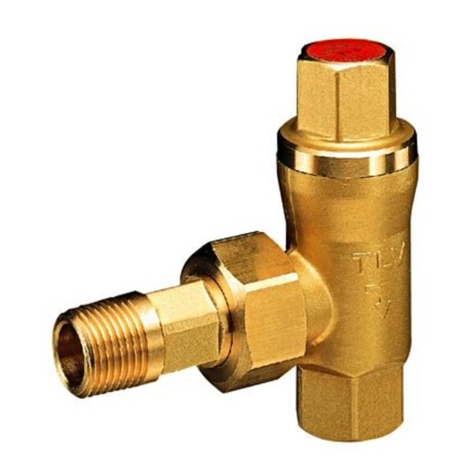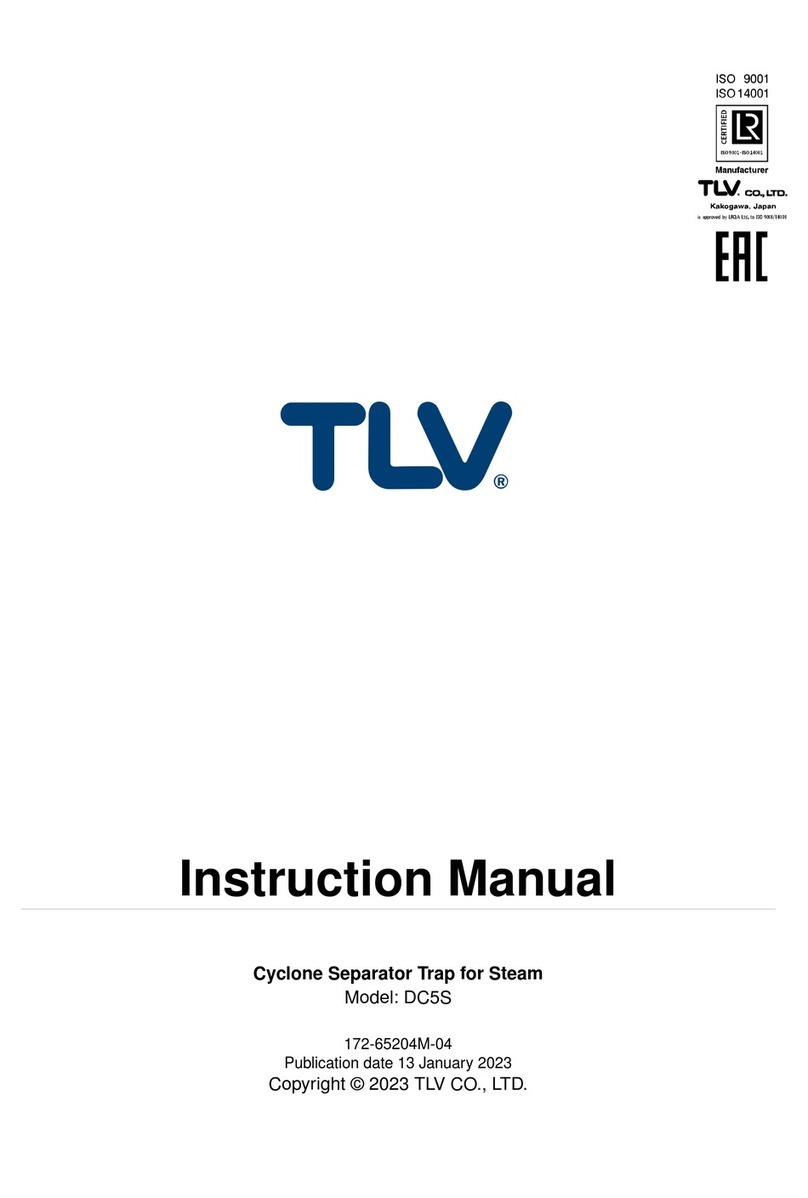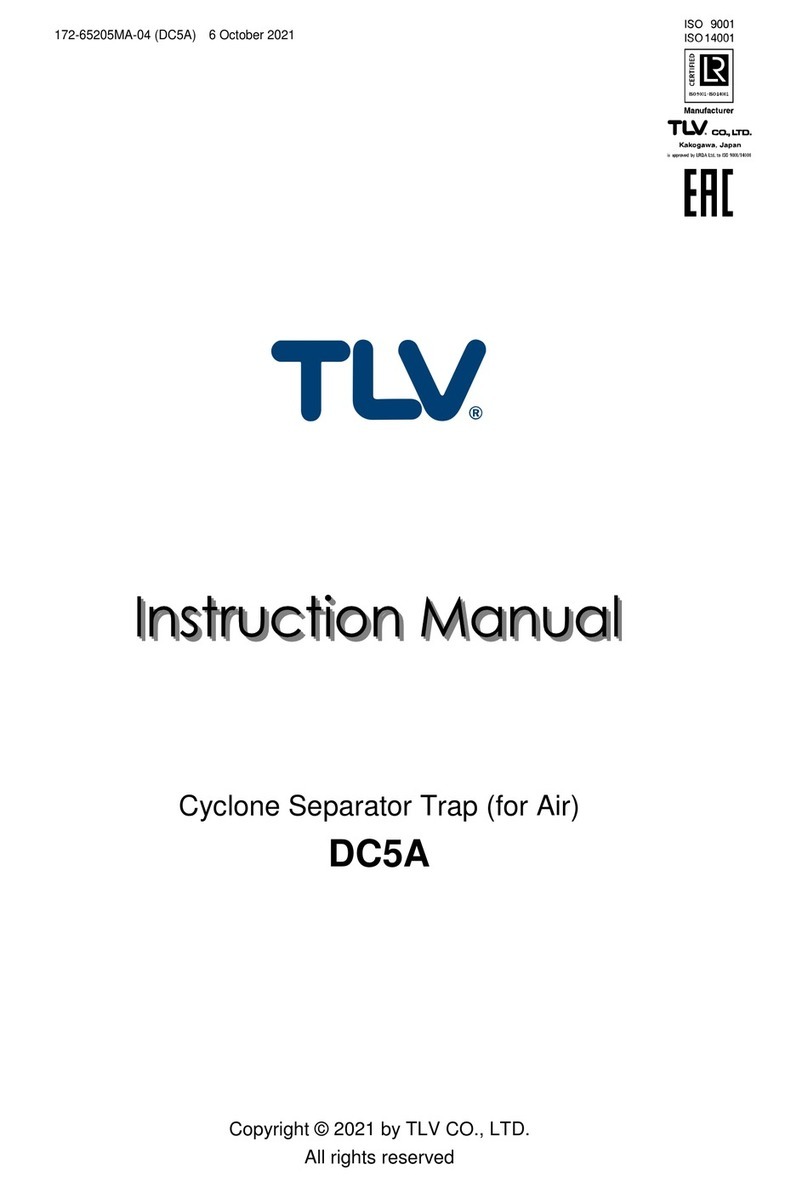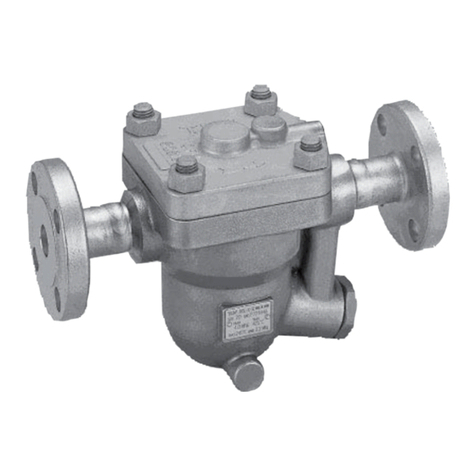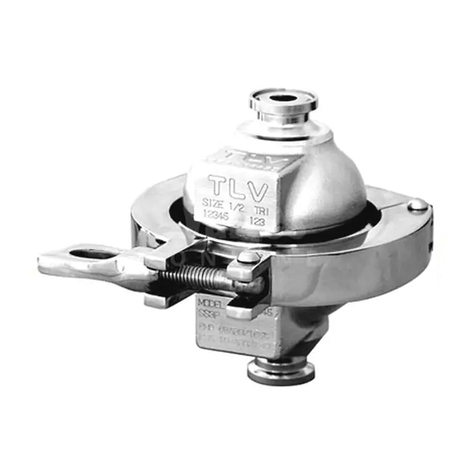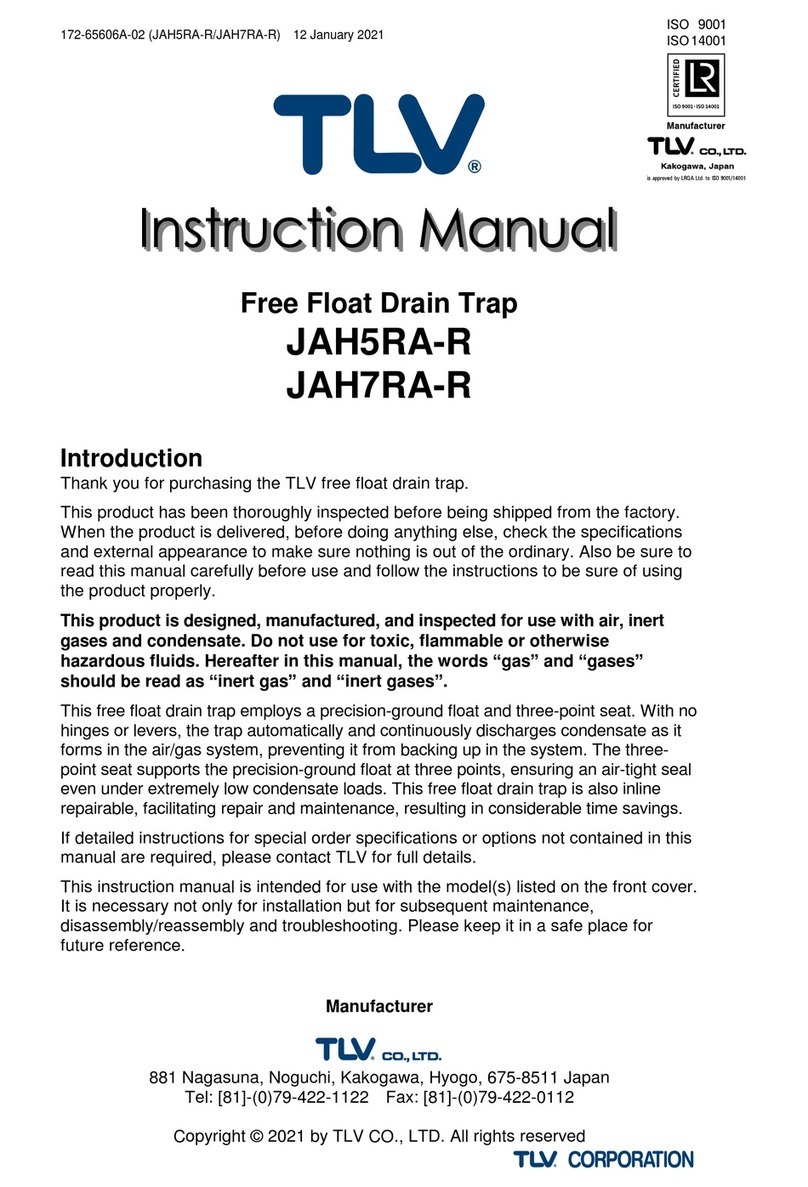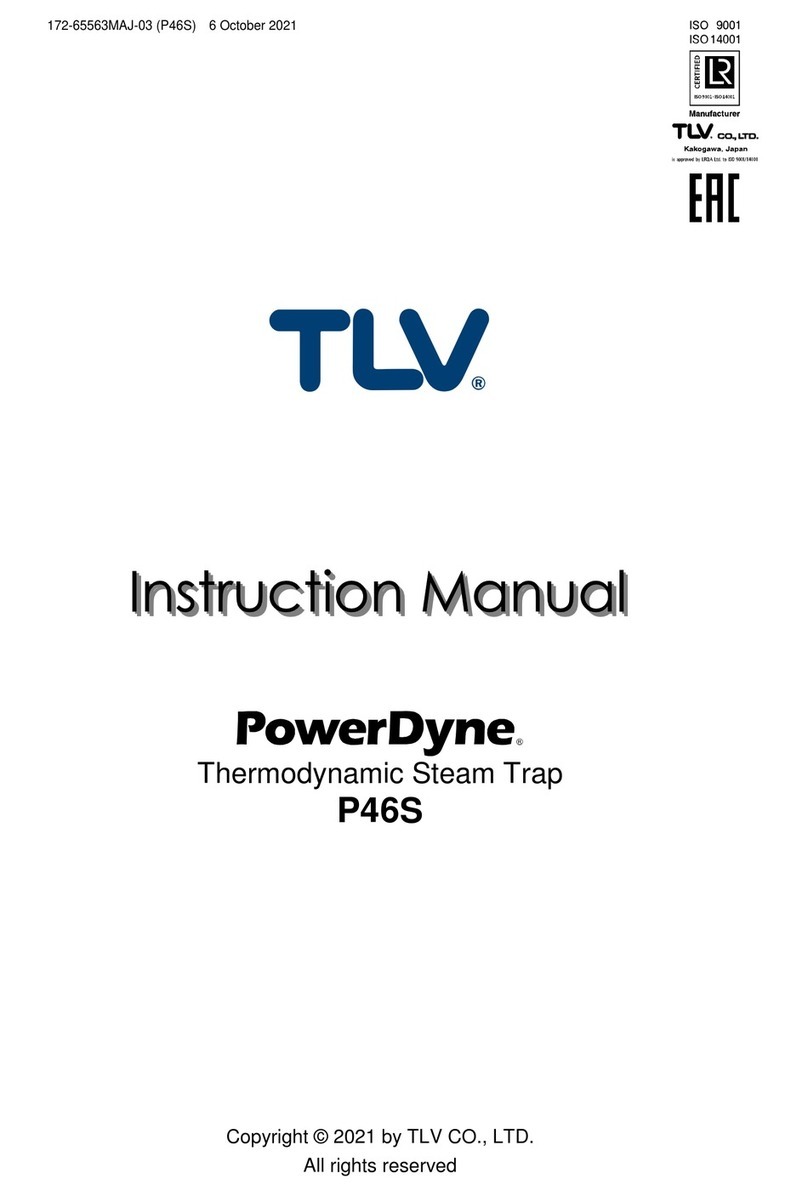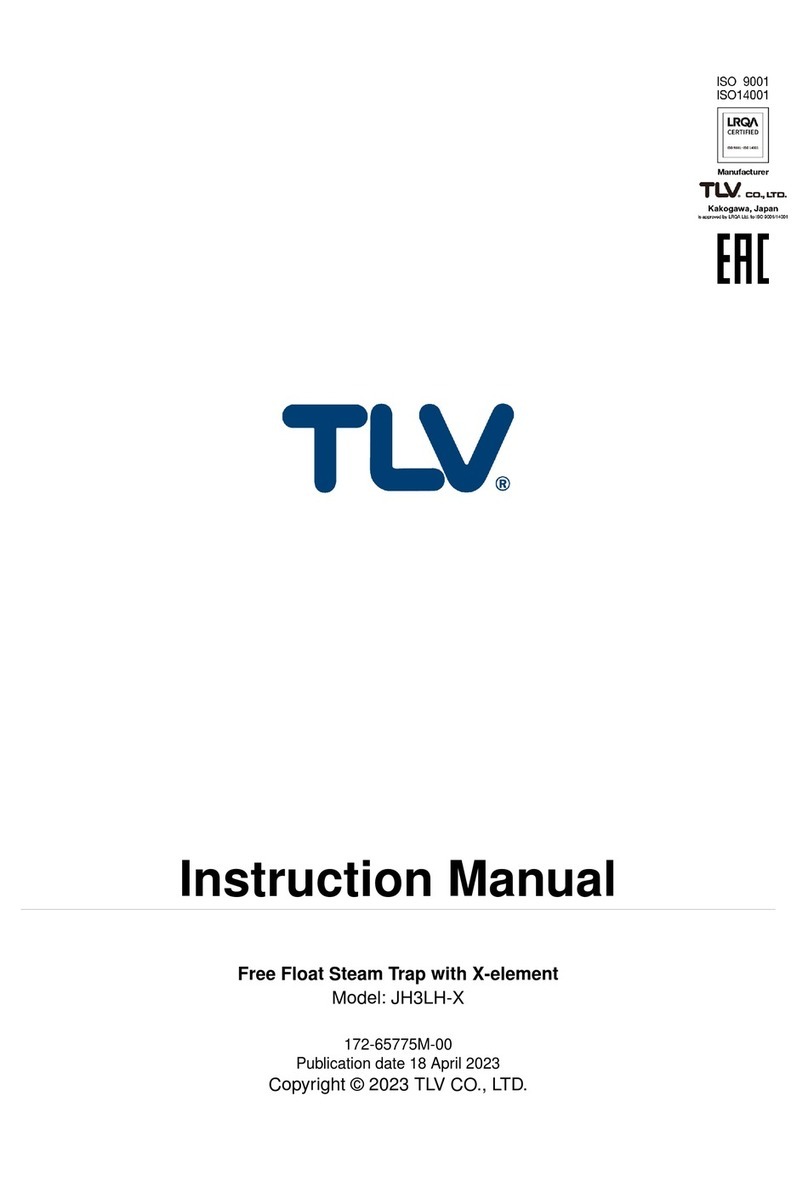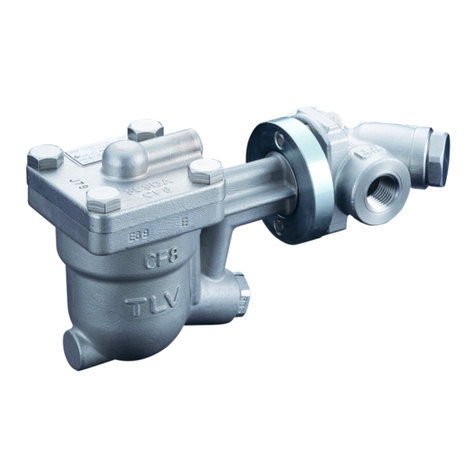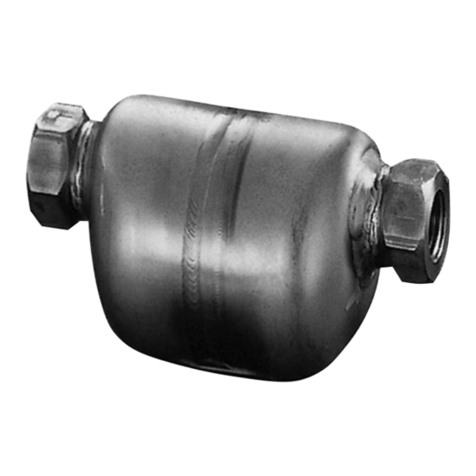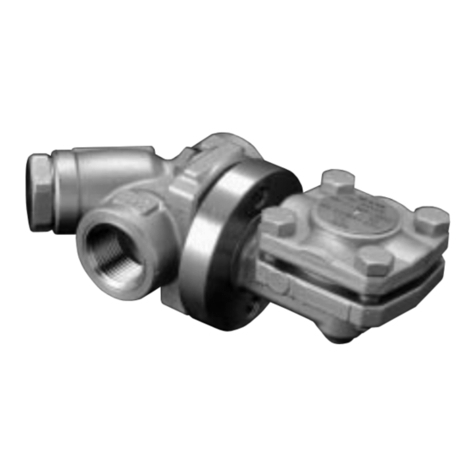TLV JH7.5R-P User manual

Instruction Manual
Free Float Steam Trap
Featured Model: JH7.5R-P
Optional Models: JH7.5R-W/JH7.5R-F/JH7.5R-V
172-65462M-06
Publication date 20 October 2022
Copyright © 2022 TLV CO., LTD.

Table of Contents
Introduction ............................................................................................................................... 3
Safety Considerations .............................................................................................................. 4
Checking the Piping .................................................................................................................. 6
Operation .................................................................................................................................. 7
Specifications ........................................................................................................................... 8
Configuration ............................................................................................................................ 9
Installation .............................................................................................................................. 10
Maintenance ........................................................................................................................... 11
Disassembly/Reassembly ...................................................................................................... 13
Instructions for Plug/Holder Disassembly and Reassembly ................................................... 16
Troubleshooting ...................................................................................................................... 17
TLV EXPRESS LIMITED WARRANTY ................................................................................... 18
Service ................................................................................................................................... 20
Options ................................................................................................................................... 21
2

Introduction
Thank you for purchasing the TLV free float steam trap.
This product has been thoroughly inspected before being shipped from the factory. When
the product is delivered, before doing anything else, check the specifications and external
appearance to make sure nothing is out of the ordinary. Also be sure to read this manual
carefully before use and follow the instructions to be sure of using the product properly.
This instruction manual is edited based on the JH-P Series (with cover plug). The JH-W Series
(with socket welded cover connection), JH-F Series (with flanged cover connection) and JH-V
Series (with manual air vent valve) are described at the end of this manual in the 'Option’
section.
This free float steam trap employs a hinge-less and lever-less free float to rapidly,
automatically and continuously discharge the inflowing condensate that is continuously
generated inside the equipment, thus preventing the accumulation of condensate and thereby
improving the heat transfer efficiency of the equipment.
This free float steam trap employs a hinge-less and lever-less free float to rapidly,
automatically and continuously discharge the inflowing condensate that is continuously
generated inside the equipment, thus preventing the accumulation of condensate and thereby
improving the heat transfer efficiency of the equipment.
If detailed instructions for special order specifications or options not contained in this manual
are required, please contact TLV for full details.
This instruction manual is intended for use with the model(s) listed on the front cover. It is
necessary not only for installation, but for subsequent maintenance, disassembly/reassembly
and troubleshooting. Please keep it in a safe place for future reference.
3

Safety Considerations
• Read this section carefully before use and be sure to follow the instructions.
• Installation, inspection, maintenance, repairs, disassembly, adjustment and valve opening/
closing should be carried out only by trained maintenance personnel.
• The precautions listed in this manual are designed to ensure safety and prevent equipment
damage and personal injury. For situations that may occur as a result of erroneous handling,
three different types of cautionary items are used to indicate the degree of urgency and the
scale of potential damage and danger: DANGER, WARNING and CAUTION.
• The three types of cautionary items above are very important for safety: be sure to observe
all of them as they relate to installation, use, maintenance and repair. Furthermore, TLV
accepts no responsibility for any accidents or damage occurring as a result of failure to
observe these precautions.
Cautionary items and definitions
Danger
Indicates an urgent situation which poses a threat of death or serious injury
Warning
Indicates that there is a potential threat of death or serious injury
Caution
Indicates that there is a possibility of injury or equipment/product damage
Safety Considerations for the Product
Warning
NEVER apply direct heat to the float. The float may explode due to increased internal pressure,
causing accidents leading to serious injury or damage to property and equipment.
Caution
Install properly and DO NOT use this product outside the recommended operating
pressure, temperature and other specification ranges. Improper use may result in such
hazards as damage to the product or malfunctions that may lead to serious accidents. Local
regulations may restrict the use of this product to below the conditions quoted.
Caution
DO NOT use this product in excess of the maximum operating pressure differential. Such
use could make discharge impossible (blocked).
Caution
Use hoisting equipment for heavy objects (weighing approximately 20 kg (44 lb) or more).
Failure to do so may result in back strain or other injury if the object should fall.
Caution
Take measures to prevent people from coming into direct contact with product outlets.
Failure to do so may result in burns or other injury from the discharge of fluids.
Caution
When disassembling or removing the product, wait until the internal pressure equals
atmospheric pressure and the surface of the product has cooled to room temperature.
Disassembling or removing the product when it is hot or under pressure may lead to discharge of
fluids, causing burns, other injuries or damage.
4

Caution
Be sure to use only the recommended components when repairing the product, and NEVER
attempt to modify the product in any way. Failure to observe these precautions may result in
damage to the product and burns or other injury due to malfunction or the discharge of fluids.
Caution
Use only under conditions in which no freeze-up will occur. Freezing may damage the
product, leading to fluid discharge, which may cause burns or other injury.
Caution
Use only under conditions in which no water hammer will occur. The impact of water hammer
may damage the product, leading to fluid discharge, which may cause burns or other injury.
5

Checking the Piping
Caution
Use only under conditions in which no water hammer will occur. The impact of water hammer
may damage the product, leading to fluid discharge, which may cause burns or other injury.
Check to make sure that the pipes to be connected to the product have been installed
properly.
1. Is the pipe diameter suitable?
2. Is the piping where the product is to be installed horizontal?
3. Has sufficient space been secured for maintenance?
4. Have isolation valves been installed at the inlet and outlet? If the outlet is subject to back
pressure, has a check valve (TLV-CK) been installed?
5. Is a bypass valve installed?
6. Is the inlet pipe as short as possible, with as few bends as possible, and installed so the
liquid will flow naturally down into the product?
7. Has the piping work been done correctly, as shown in the figures below?
Requirement Correct Incorrect
Install catchpot with the proper
diameter.
Diameter is too small.
Make sure the flow of
condensate is not obstructed.
Diameter is too small and inlet
protrudes into pipe interior.
To prevent rust and scale from
flowing into the product, the inlet
pipe should be connected 25 to
50 mm above the base of the
T-pipe.
Rust and scale flow into the
trap with the condensate.
When installing on the blind
end, make sure the flow of
condensate is not obstructed.
Condensate collects in the
pipe.
6

Operation
Principles of condensate discharge:
As much air as possible should be eliminated at start-up using a bypass valve or blowdown
line.
1. Condensate Discharge
As steam is supplied, condensate flow begins. The rising condensate level causes the
float to rise due to buoyancy, opening the orifice (A) and allowing condensate to be
discharged.
2. Discharge of Large Quantities of Condensate
Increases in the condensate inflow rate cause the condensate level in the trap to rise.
The float consequently rises and enlarges the opening of the orifice (A), allowing more
condensate to be discharged. In this manner, continuous condensate discharge occurs
while the opening size of the orifice varies depending on the condensate flow rate.
3. Closed Position
When the condensate flow rate decreases, the float falls, closing off the orifice (A)
opening. A water seal is maintained at all times over the orifice (A) to prevent steam
loss.
Air
Steam
Condensate
7

Specifications
Caution
Install properly and DO NOT use this product outside the recommended operating
pressure, temperature and other specification ranges. Improper use may result in such
hazards as damage to the product or malfunctions that may lead to serious accidents. Local
regulations may restrict the use of this product to below the conditions quoted.
DO NOT use this product in excess of the maximum operating pressure differential. Such
use could make discharge impossible (blocked).
Use only under conditions in which no freeze-up will occur. Freezing may damage the unit,
leading to fluid discharge, which may different cause burns or other injury.
A Model
B Nominal Diameter
C Maximum Allowable Pressure (PMA) 01
D Maximum Allowable Temperature (TMA) 01
E Maximum Operating Temperature (TMO)
F Maximum Differential Pressure (PMX)
G Production Lot No.
H Valve No. 02
01Maximum allowable pressure (PMA) and maximum allowable temperature (TMA) are PRESSURE
SHELL DESIGN CONDITIONS, NOT OPERATING CONDITIONS.
02Valve No. is displayed for products with options. This item is omitted from the nameplate when there
are no options.
8

Configuration
No. Part Name Maintenance
Kit Repair Kit Float
1 Body
2 Cover
3 Float ✓
4 Orifice ✓
5 Orifice Gasket ✓ ✓
6 Orifice Plug
7 Orifice Plug Gasket ✓ ✓
8 Screen ✓
9 Screen Holder
10 Snap Ring
11 Cover Gasket ✓ ✓
12 Cover Bolt
13 Cover Nut
14 Nameplate
15 Screen Holder Retainer
16 Flange/Socket
17 Drain Plug Gasket ✓ ✓
18 Drain Plug
19 Plug Gasket ✓ ✓
20 Plug
21 Cover Plug Gasket ✓ ✓
22 Cover Plug
9

Installation
Caution
Install properly and DO NOT use this product outside the recommended operating
pressure, temperature and other specification ranges. Improper use may result in such
hazards as damage to the product or malfunctions that may lead to serious accidents. Local
regulations may restrict the use of this product to below the conditions quoted.
Use hoisting equipment for heavy objects (weighing approximately 20 kg (44 lb) or more).
Failure to do so may result in back strain or other injury if the object should fall.
Take measures to prevent people from coming into direct contact with product outlets.
Failure to do so may result in burns or other injury from the discharge of fluids.
Installation, inspection, maintenance, repairs, disassembly and adjustment and valve opening/
closing should be carried out only by trained maintenance personnel.
1. Before installation, be sure to remove all protective seals.
2. Before installing the product, open the inlet valve and blow out the piping to remove any
piping scraps, dirt and oil. Close the inlet valve after blowdown.
3. Install the product so the arrow on the body is pointing in the direction of flow.
4. The product should be inclined no more than 5° horizontally and front-to-back.
5. Install a condensate outlet valve and outlet piping.
6. Air in the system at start-up should be discharged using a bypass valve or blowdown line.
7. Open the inlet and outlet valves and ensure that the product functions properly.
If there is a problem, determine the cause using the "Troubleshooting" section in this manual.
Tolerance Angle for Installation: 5°
Make sure the product is installed with the raised TLV lettering on the body horizontal.
10

Maintenance
Caution
Take measures to prevent people from coming into direct contact with product outlets.
Failure to do so may result in burns or other injury from the discharge of fluids.
Be sure to use only the recommended components when repairing the product, and NEVER
attempt to modify the product in any way. Failure to observe these precautions may result in
damage to the product and burns or other injury due to malfunction or the discharge of fluids.
Operational Check
A visual inspection of the following items should be done on a daily basis to determine
whether the product is operating properly or has failed. Periodically (at least biannually) the
operation should also be checked by using diagnostic equipment such as a stethoscope,
thermometer, TLV Pocket TrapMan or TLV TrapMan.
If the product should fail, it may cause damage to piping and equipment, resulting in faulty or
low quality products or losses due to steam leakage.
Normal: Condensate is discharged continuously, together with flash steam, and the
sound of flow can be heard. If there is very little condensate, there is almost
no sound of flow.
Blocked
(Discharge
Impossible):
No condensate is discharged. The product is quiet and makes no noise, and the
surface temperature of the product is low.
Blowing: Live steam continually flows from the outlet and there is a continuous metallic
sound.
Steam Leakage: Live steam is discharged through the product outlet together with condensate,
accompanied by a high-pitched sound.
(When conducting a visual inspection, flash steam is sometimes mistaken for steam leakage.
For this reason, the use of a steam trap diagnostic instrument such as TLV TrapMan in
conjunction with the visual inspection is highly recommended.)
Flash Steam Live Steam Leakage
White jet containing water droplets Clear, slightly bluish jet
11

Parts Inspection
When parts have been removed, or during periodic inspections, use the following table to
inspect the parts and replace any that are found to be defective.
Gaskets: Check for warping or scratches
Screen: Check for clogging or corrosion
Float: Check for scratches or dents
Body Interior: Check for build-up
Orifice Opening: Check for dirt, oil film, wear or scratches
12

Disassembly/Reassembly
Warning
NEVER apply direct heat to the float. The float may explode due to increased internal pressure,
causing accidents leading to serious injury or damage to property and equipment.
Caution
Use hoisting equipment for heavy objects (weighing approximately 20 kg (44 lb) or more).
Failure to do so may result in back strain or other injury if the object should fall.
When disassembling or removing the product, wait until the internal pressure equals
atmospheric pressure and the surface of the product has cooled to room temperature.
Disassembling or removing the product when it is hot or under pressure may lead to discharge of
fluids, causing burns, other injuries or damage.
Use the following procedures to remove components. Use the same procedures in reverse to
reassemble. (Installation, inspection, maintenance, repairs, disassembly, adjustment and valve
opening/closing should be carried out only by trained maintenance personnel.)
Drain Plug
Part Name & No. During Disassembly During Reassembly
Drain Plug 18 Remove with a socket wrench Consult the table of tightening torques
and tighten to the proper torque
Drain Plug
Gasket 19 Remove the gasket and clean sealing
surfaces Replace with a new gasket; coat
surfaces with anti-seize
Detaching/Reattaching the Cover and its Components
Part Name & No. During Disassembly During Reassembly
Cover Nut 13 Remove with a socket wrench Consult the table of tightening torques
and tighten to the proper torque
Cover 2 Remove, being careful not to scratch
the gasket sealing surface Make sure there are no pieces of the
old gasket left on the sealing surfaces
of the body and cover, align the arrows
on the body and cover and reattach
Cover Gasket 11 Remove the gasket and clean sealing
surfaces Replace with a new gasket
Cover Plug 22 Remove with a socket wrench Consult the table of tightening torques
and tighten to the proper torque
Cover Plug
Gasket 21 Remove the gasket and clean sealing
surfaces Replace with a new gasket; coat
surfaces with anti-seize
13

Disassembly/Reassembly of Components Inside the Body
Note
The plug (inside the body) must be removed before the float can be removed.
Part Name During Disassembly During Reassembly
Plug (inside the
body) 20 Remove with a socket wrench Consult the table of tightening torques
and tighten to the proper torque
Plug Gasket 19 Remove the gasket and clean sealing
surfaces Replace with a new gasket; coat
surfaces with anti-seize
Snap Ring 10 Pinch insides together and remove
from the body Insert securely into the groove in the
body
Screen 8 Remove by grasping the wire ring and
lifting straight up and out Set the screen on the screen holder
and screen holder retainer and insert
as far as the snap ring groove
Screen Holder
Retainer 15 Remove without bending Place on the screen holder without
tilting
Screen Holder 9 Remove without bending Place on the ledge inside the body,
making sure the rounded side is on top
Float 3 Remove, being careful not to scratch
the polished surface Insert, being careful not to scratch the
polished surface
Orifice Plug 6 Remove with a socket wrench Consult the table of tightening torques
and tighten to the proper torque
Orifice Plug
Gasket 7 Remove the gasket and clean sealing
surfaces Replace with a new gasket; coat
surfaces with anti-seize
Orifice 4 Remove with a socket wrench Consult the table of tightening torques
and tighten to the proper torque
Orifice Gasket 5 Remove the gasket and clean sealing
surfaces Replace with a new gasket; coat
surfaces with anti-seize
Table of Tightening Torques
Part Name & No. Torque
N‧mDistance Across Flats
mm
Orifice 4 600 46
Orifice Plug 6 800 46
Cover Nut 13 200 30
Cover Plug (JH7.5R-P) 22 100 26
Plug (inside the body) 20 150 27
Drain Plug 18 100 26
Note
• Coat all threaded portions and valve seat gasket with anti-seize.
• If drawings or other special documentation were supplied for the product, any torque given there
takes precedence over values shown here.
14

Exploded View
No. Part Name No. Part Name
1 Body 12 Cover Bolt
2 Cover 13 Cover Nut
3 Float 14 Nameplate
4 Orifice 15 Screen Holder Retainer
5 Orifice Gasket 16 Flange/Socket
6 Orifice Plug 17 Drain Plug Gasket
7 Orifice Plug Gasket 18 Drain Plug
8 Screen 19 Plug Gasket
9 Screen Holder 20 Plug
10 Snap Ring 21 Cover Plug Gasket
11 Cover Gasket 22 Cover Plug
15

Instructions for Plug/Holder Disassembly and
Reassembly
The seal on the threaded plugs/holders found on TLV products is formed by a flat metal
gasket. There are various installation orientations for the gaskets, such as horizontal, diagonal
and downward, and the gasket may be pinched in the thread recesses during assembly.
Instructions for Disassembly and Reassembly
1. Remove the plug/holder using a tool of the specified size (distance across flats).
2. The gasket should not be reused. Be sure to replace it with a new gasket.
3. Clean the gasket surfaces of the plug/holder and the product body using a rag and/or
cleaning agents, then check to make sure the surfaces are not scratched or deformed.
4. Coat both the gasket surface of the plug/holder and the threads of the plug/holder with
anti-seize, then press the gasket onto the center of the gasket surface of the plug/holder,
making sure the anti-seize affixes the gasket tightly to the plug/holder. Check to make sure
the gasket is not caught in the recesses of the threads.
5. Hold the plug/holder upside down to make sure that the anti-seize makes the gasket stick
to the plug/holder even when the plug/holder is held upside down.
6. Screw the plug/holder by hand into the product body while making sure that the gasket
remains tightly affixed to the center of the gasket surface of the plug/holder. Make sure
the entire gasket is making contact with the gasket surface of the product body. It is
important at this point to make sure the gasket is not pinched in the thread recesses of the
plug/holder.
7. Tighten the plug/holder to the proper torque.
8. Next, begin the supply of steam and check to make sure there is no leakage from the
part just tightened. If there is leakage, immediately close the inlet valve and, if there is a
bypass valve, take the necessary steps to release any residual pressure. After the surface
of the product cools to room temperature, repeat the procedure beginning from step 1.
16

Troubleshooting
Warning
NEVER apply direct heat to the float. The float may explode due to increased internal pressure,
causing accidents leading to serious injury or damage to property and equipment.
Caution
When disassembling or removing the product, wait until the internal pressure equals
atmospheric pressure and the surface of the product has cooled to room temperature.
Disassembling or removing the product when it is hot or under pressure may lead to discharge of
fluids, causing burns, other injuries or damage.
If the product fails to operate properly, use the following table to locate the cause and remedy.
Problem Cause Remedy
No condensate
is discharged
(blocked) or
discharge is poor
The float is damaged or filled with
condensate Replace with a new float
The orifice opening, screen or piping
are clogged with rust and scale Clean parts
Air binding has occurred Perform a bypass blowdown or
consider switching to a product with a
built-in air vent or air vent valve
Steam-locking has occurred Perform a bypass blowdown or close
the product inlet valve and allow the
product to cool
The product operating pressure
exceeds the maximum specified
pressure, or whether there is
insufficient pressure differential
between the product inlet and outlet
Compare specifications and actual
operating conditions
Steam is
discharged or
leaks from the
outlet
(blowing)
(steam leakage)
Build-up on the seating surface of
the orifice or rust and scale build-up
beneath the float
Clean parts
Scratches on the orifice Replace with a new orifice
The float is misshapen or has a build-
up Clean or replace with a new float
Improper installation orientation Correct the installation
Product vibration Lengthen the inlet piping and fasten it
securely
Steam is leaking
from a place other
than the outlet
Gasket deterioration or damage Replace with new gasket(s)
Improper tightening torques were used Tighten to the proper torque
Float frequently
becomes
damaged
Water hammer has occurred Study and correct the piping
Note
When replacing parts with new, use the parts list for reference, and replace with parts from the
Maintenance Kit, Repair Kit, etc. Please note that replacement parts are only available as part of a
replacement parts kit.
17

TLV EXPRESS LIMITED WARRANTY
Subject to the limitations set forth below, TLV CO., LTD., a Japanese corporation (“TLV”),
warrants that products which are sold by it, TLV International Inc. (“TII”) or one of its
group companies excluding TLV Corporation (a corporation of the United States of America),
(hereinafter the “Products”) are designed and manufactured by TLV, conform to the
specifications published by TLV for the corresponding part numbers (the “Specifications”)
and are free from defective workmanship and materials. The party from whom the Products
were purchased shall be known hereinafter as the “Seller”. With regard to products or
components manufactured by unrelated third parties (the “Components”), TLV provides no
warranty other than the warranty from the third party manufacturer(s), if any.
Exceptions to Warranty
This warranty does not cover defects or failures caused by:
1. improper shipping, installation, use, handling, etc., by persons other than TLV, TII or TLV
group company personnel, or service representatives authorized by TLV; or
2. dirt, scale or rust, etc.; or
3. improper disassembly and reassembly, or inadequate inspection and maintenance by
persons other than TLV or TLV group company personnel, or service representatives
authorized by TLV; or
4. disasters or forces of nature or Acts of God; or
5. abuse, abnormal use, accidents or any other cause beyond the control of TLV, TII or TLV
group companies; or
6. improper storage, maintenance or repair; or
7. operation of the Products not in accordance with instructions issued with the Products or
with accepted industry practices; or
8. use for a purpose or in a manner for which the Products were not intended; or
9. use of the Products in a manner inconsistent with the Specifications; or
10. use of the Products with Hazardous Fluids (fluids other than steam, air, water, nitrogen,
carbon dioxide and inert gases (helium, neon, argon, krypton, xenon and radon)); or
11. failure to follow the instructions contained in the TLV Instruction Manual for the Product.
Duration of Warranty
This warranty is effective for a period of one (1) year after delivery of Products to the first end
user. Notwithstanding the foregoing, asserting a claim under this warranty must be brought
within three (3) years after the date of delivery to the initial buyer if not sold initially to the first
end user.
ANY IMPLIED WARRANTIES NOT NEGATED HEREBY WHICH MAY ARISE BY
OPERATION OF LAW, INCLUDING THE IMPLIED WARRANTIES OF MERCHANTABILITY
AND FITNESS FOR A PARTICULAR PURPOSE AND ANY EXPRESS WARRANTIES NOT
NEGATED HEREBY, ARE GIVEN SOLELY TO THE INITIAL BUYER AND ARE LIMITED IN
DURATION TO ONE (1) YEAR FROM THE DATE OF SHIPMENT BY THE SELLER.
Exclusive Remedy
THE EXCLUSIVE REMEDY UNDER THIS WARRANTY, UNDER ANY EXPRESS
WARRANTY OR UNDER ANY IMPLIED WARRANTIES NOT NEGATED HEREBY
(INCLUDING THE IMPLIED WARRANTIES OF MERCHANTABILITY AND FITNESS FOR A
PARTICULAR PURPOSE), IS REPLACEMENT; PROVIDED: (a) THE CLAIMED DEFECT IS
18

REPORTED TO THE SELLER IN WRITING WITHIN THE WARRANTY PERIOD, INCLUDING
A DETAILED WRITTEN DESCRIPTION OF THE CLAIMED DEFECT AND HOW AND WHEN
THE CLAIMED DEFECTIVE PRODUCT WAS USED; AND (b) THE CLAIMED DEFECTIVE
PRODUCT AND A COPY OF THE PURCHASE INVOICE IS RETURNED TO THE SELLER,
FREIGHT AND TRANSPORTATION COSTS PREPAID, UNDER A RETURN MATERIAL
AUTHORIZATION AND TRACKING NUMBER ISSUED BY THE SELLER. ALL LABOR
COSTS, SHIPPING COSTS, AND TRANSPORTATION COSTS ASSOCIATED WITH THE
RETURN OR REPLACEMENT OF THE CLAIMED DEFECTIVE PRODUCT ARE SOLELY
THE RESPONSIBILITY OF BUYER OR THE FIRST END USER. THE SELLER RESERVES
THE RIGHT TO INSPECT ON THE FIRST END USER’S SITE ANY PRODUCTS CLAIMED
TO BE DEFECTIVE BEFORE ISSUING A RETURN MATERIAL AUTHORIZATION. SHOULD
SUCH INSPECTION REVEAL, IN THE SELLER’S REASONABLE DISCRETION, THAT THE
CLAIMED DEFECT IS NOT COVERED BY THIS WARRANTY, THE PARTY ASSERTING
THIS WARRANTY SHALL PAY THE SELLER FOR THE TIME AND EXPENSES RELATED
TO SUCH ON-SITE INSPECTION.
Exclusion of Consequential and Incidental Damages
IT IS SPECIFICALLY ACKNOWLEDGED THAT THIS WARRANTY, ANY OTHER EXPRESS
WARRANTY NOT NEGATED HEREBY, AND ANY IMPLIED WARRANTY NOT NEGATED
HEREBY, INCLUDING THE IMPLIED WARRANTIES OF MERCHANTABILITY AND
FITNESS FOR A PARTICULAR PURPOSE, DO NOT COVER, AND NEITHER TLV,
TII NOR ITS TLV GROUP COMPANIES WILL IN ANY EVENT BE LIABLE FOR,
INCIDENTAL OR CONSEQUENTIAL DAMAGES, INCLUDING, BUT NOT LIMITED TO
LOST PROFITS, THE COST OF DISASSEMBLY AND SHIPMENT OF THE DEFECTIVE
PRODUCT, INJURY TO OTHER PROPERTY, DAMAGE TO BUYER’S OR THE FIRST
END USER’S PRODUCT, DAMAGE TO BUYER’S OR THE FIRST END USER’S
PROCESSES, LOSS OF USE, OR OTHER COMMERCIAL LOSSES. WHERE, DUE TO
OPERATION OF LAW, CONSEQUENTIAL AND INCIDENTAL DAMAGES UNDER THIS
WARRANTY, UNDER ANY OTHER EXPRESS WARRANTY NOT NEGATED HEREBY
OR UNDER ANY IMPLIED WARRANTY NOT NEGATED HEREBY (INCLUDING THE
IMPLIED WARRANTIES OF MERCHANTABILITY AND FITNESS FOR A PARTICULAR
PURPOSE) CANNOT BE EXCLUDED, SUCH DAMAGES ARE EXPRESSLY LIMITED IN
AMOUNT TO THE PURCHASE PRICE OF THE DEFECTIVE PRODUCT. THIS EXCLUSION
OF CONSEQUENTIAL AND INCIDENTAL DAMAGES, AND THE PROVISION OF THIS
WARRANTY LIMITING REMEDIES HEREUNDER TO REPLACEMENT, ARE INDEPENDENT
PROVISIONS, AND ANY DETERMINATION THAT THE LIMITATION OF REMEDIES FAILS
OF ITS ESSENTIAL PURPOSE OR ANY OTHER DETERMINATION THAT EITHER OF THE
ABOVE REMEDIES IS UNENFORCEABLE, SHALL NOT BE CONSTRUED TO MAKE THE
OTHER PROVISIONS UNENFORCEABLE.
Exclusion of Other Warranties
THIS WARRANTY IS IN LIEU OF ALL OTHER WARRANTIES, EXPRESS OR IMPLIED,
AND ALL OTHER WARRANTIES, INCLUDING BUT NOT LIMITED TO THE IMPLIED
WARRANTIES OF MERCHANTABILITY AND FITNESS FOR A PARTICULAR PURPOSE,
ARE EXPRESSLY DISCLAIMED.
Severability
Any provision of this warranty which is invalid, prohibited or unenforceable in any jurisdiction
shall, as to such jurisdiction, be ineffective to the extent of such invalidity, prohibition
or unenforceability without invalidating the remaining provisions hereof, and any such
invalidity, prohibition or unenforceability in any such jurisdiction shall not invalidate or render
unenforceable such provision in any other jurisdiction.
19

Service
For Service or Technical Assistance: Contact your TLV representative or your regional TLV
office.
In Europe:
Daimler-Benz-Straße 16-18, 74915 Waibstadt, Germany Tel:
Fax: [49]-(0)7263-9150-0
[49]-(0)7263-9150-50
Units 7 & 8, Furlong Business Park, Bishops Cleeve,
Gloucestershire GL52 8TW, U.K.
Tel:
Fax: [44]-(0)1242-227223
[44]-(0)1242-223077
Parc d’Ariane 2, bât. C, 290 rue Ferdinand Perrier, 69800 Saint
Priest, France
Tel:
Fax: [33]-(0)4-72482222
[33]-(0)4-72482220
In North America:
13901 South Lakes Drive, Charlotte, NC 28273-6790, U.S.A. Tel:
Fax: [1]-704-597-9070
[1]-704-583-1610
Av. Jesús del Monte 39-B-1001, Col. Hda. de las Palmas,
Huixquilucan, Edo. de México, 52763, Mexico
Tel:
Fax: [52]-55-5359-7949
[52]-55-5359-7585
In Oceania:
Unit 8, 137-145 Rooks Road, Nunawading, Victoria 3131,
Australia
Tel:
Fax: [61]-(0)3-9873 5610
[61]-(0)3-9873 5010
In East Asia:
36 Kaki Bukit Place, #02-01/02, Singapore 416214 Tel:
Fax: [65]-6747 4600
[65]-6742 0345
5/F, Building 7, No.103 Caobao Road, Xuhui District, Shanghai,
China 200233
Tel:
Fax: [86]-(0)21-6482-8622
[86]-(0)21-6482-8623
No.16, Jalan MJ14, Taman Industri Meranti Jaya, 47120 Puchong,
Selangor, Malaysia
Tel:
Fax: [60]-3-8052-2928
[60]-3-8051-0899
252/94 (K-L) 17th Floor, Muang Thai-Phatra Complex Tower B,
Rachadaphisek Road, Huaykwang, Bangkok 10310, Thailand
Tel:
Fax: [66]-2-693-3799
[66]-2-693-3979
#302-1 Bundang Technopark B, 723 Pangyo-ro, Bundang,
Seongnam, Gyeonggi, 13511, Korea
Tel:
Fax: [82]-(0)31-726-2105
[82]-(0)31-726-2195
In the Middle East:
Building 2W, No. M002, PO Box 371684, Dubai Airport Free Zone,
Dubai, UAE
Email: sales-me@tlv.co.jp
In Other Countries:
881 Nagasuna, Noguchi, Kakogawa, Hyogo 675-8511, Japan
Tel:
Fax: [81]-(0)79-427-1818
[81]-(0)79-425-1167
Manufacturer:
881 Nagasuna, Noguchi, Kakogawa, Hyogo 675-8511, Japan Tel:
Fax: [81]-(0)79-427-1800
[81]-(0)79-422-2277
20
This manual suits for next models
3
Table of contents
Other TLV Industrial Equipment manuals
